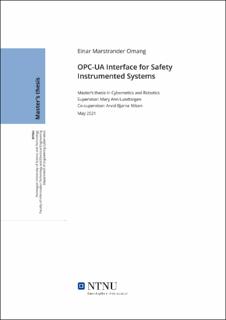| dc.description.abstract | This thesis explores the challenges and limitations of creating an OPC-UA (Open Platform Communications - Unified Architecture) server based on the OPC-UA information model for APOS developed in the autumn 2020 specialization project APOS OPC-UA[34]. The APOS[39] project at SINTEF defines a standard information model for safety instrumented systems, and the specialization project suggests how this can be realized in OPC-UA. Safety instrumented systems refer to instrumented systems in industrial settings that are exclusively used to prevent and detect dangerous events. OPC-UA is a modern standard for industrial communication and information modeling.
In the field of safety instrumented systems it is important to contextualize and organize failure events in order to measure the failure rates of various field equipment types. The APOS model is developed with this in mind. Today, collecting this information involves a great deal of manual work, and so a part of APOS is also designing algorithms and standard procedures using the developed informationmodel to make this process more automatic. The specialization project suggests an OPC-UA implementation of the APOS model. This thesis is an extension of that project, and details the development of an OPC-UA server using the information model exposing industrial information from three information management systems at Aker BP: an LCI (Life Cycle Information) database running MS SQL Server, a SAP[17] (Systems, Applications, and Products in Data Processing) system, and a central repository for equipment named EqHub[12], managed by Sharecat[18].
Through this process, limitations and challenges in both the APOS project and the Aker BP source systems are identified. First, gaining automated access to the source systems is difficult, as they are in some cases not designed to be accessed in such a way. Secondly, fitting the data in the source systems to the APOS information model was generally difficult, and in some cases impossible due to inconsistent or missing data in the source systems. Finally, once access was obtained, accessing the data was slow enough that some applications of the server became impractical.
Based on these challenges, concrete recommendations for the APOS project and Aker BP are suggested. The APOS project only applies to safety instrumented systems, whichmay make it more difficult to adapt in systems that structurally do not differentiate between safety functions and normal equipment; Both SAP and LCI are slow and difficult to access automatically; All three source systems have trouble with consistency, which makes automatic mapping to the OPC-UA model difficult; Finally, the information model is in some edge-cases potentially incompatible with the ISA-95 standard. | en_US |
| dc.description.abstract | Denne oppgaven identifiserer utfordringer og begrensninger i utviklingen av en OPC-UA (Open Platform Communications - Unified Architecture) server basert på OPC-UA informasjonsmodell for APOS utviklet høsten 2020 som en del av fordypningsprosjektet APOS OPC-UA. SINTEFs APOS prosjekt definerer en standard informasjonsmodell for instrumenterte sikkerhetssystemer, og fordypningsprosjektet foreslår en realisering av denne i OPC-UA. Instrumenterte sikkerhetssystemer er instrumenterte systemer i industriel sammenheng som kun brukes til deteksjon og prevansjon av farlige hendelser. OPC-UA er en moderne standard for industriell kommunikasjon og informasjonsmodellering.
I sammenheng med instrumenterte sikkerhetssystemer er det viktig å kontekstualisere og organisere feil for å måle feilrater av ulike utstyrstyper. APOS-modellen er designet for dette formålet. I dag involverer innhenting av denne informasjonen mye manuelt arbeid, så deler av APOS omhandler design av algoritmer og prosedyrer for å bruke informasjonsmodellen til å automatisere denne prosessen.
Fordypningsprosjketet foreslår en OPC-UA implementasjon av APOS-modellen. Denne oppgaven er en utvidelse av det prosjektet, og beskriver utviklingen av en OPC-UA server basert på denne informasjonsmodellen som henter industriell data fra tre underliggende systemer: En LCI (Life Cycle Information) database implementert med MS SQL Server, et SAP (Systems, Applications, and Products in Data Processing) system, og EqHub, et sentralt lager for utstyrsinformasjon styrt av Sharecat.
Utviklingsprosessen identifiserer en rekke begrensninger og utfordringer i både APOS prosjektet og Aker BPs kildesystemer. Uthenting av informasjonen er vanskelig, siden de ofte ikke er designet for å bli lest automatisk. Videre, tilpassing av dataen i kildesystemene til APOS-modellen er generelt vanskelig, på grunn av manglende eller inkonsistent informasjon. Selv om informasjonen til slutt lot seg anskaffe var kildesystemene generelt så trege at praktisk bruk av serveren ikke var mulig.
Basert på disse utfordringene foreslår oppgaven konkrete forbedringer til både APOS og Aker BP. APOS prosjektet gjelder kun for instrumenterte sikkerhetssystemer, som gjør det vanskeligere å bruke i systemer som ikke skiller klart mellom sikkerhetskritisk utstyr og vanlig utstyr. Både SAP og LCI er vanskelige å bruke og trege. Informasjonsmodellen viser seg å være potensielt inkompatibel med ISA-95 standarden i noen spesielle tilfeller. | en_US |
